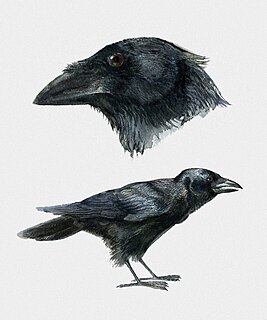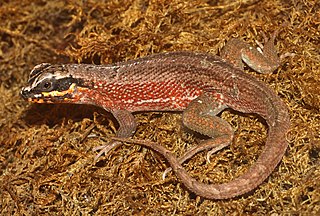
Hispaniola is an island in the Caribbean archipelago which is known as the Greater Antilles. It is the most populous island in the West Indies and the region's second largest after Cuba.

The Greater Antilles is a grouping of the larger islands in the Caribbean Sea, including Cuba, Hispaniola, Puerto Rico, Jamaica, and the Cayman Islands. Six island states share the region of the Greater Antilles in total, with Haiti and the Dominican Republic sharing the island of Hispaniola.

Solenodons are venomous, nocturnal, burrowing, insectivorous mammals belonging to the family Solenodontidae. The two living solenodon species are the Cuban solenodon, and the Hispaniolan solenodon. Both species are classified as "Endangered" due to habitat destruction and predation by non-native cats, dogs and mongooses, introduced by humans to the solenodons' home islands to control snakes and rodents.

The white-necked crow is the largest of the four Caribbean corvids. It is endemic to the island of Hispaniola. It was formerly also found on Puerto Rico, but is extirpated there, due to considerable forest clearance and hunting.

Ridgway's hawk(Buteo ridgwayi) is a bird of prey in the family Accipitridae endemic to the Dominican Republic in the Caribbean. The population of Ridgway's hawks have been declining because of habitat destruction and human persecution in the Dominican Republic, and is classified as "critically endangered".

The palm crow is a relatively small corvid that occurs mostly on the Caribbean island of Hispaniola. It was formerly quite frequent on Cuba, but has become severely reduced in number there.

Pinus occidentalis, also known as the Hispaniolan pine or Hispaniola pine, is a pine tree endemic to the island of Hispaniola.

The Hispaniolan solenodon, also known as the agouta, is a solenodon found only on Hispaniola, the island shared by the Dominican Republic and Haiti. It was first described by Brandt in 1833. A similar but smaller species, Marcano's solenodon, once lived on the island, but became extinct after European colonization.

The Hispaniolan hutia is a hutia species endemic to the island of Hispaniola. It is the only confirmed extant species of the genus Plagiodontia, and the only extant species of hutia on Hispaniola; other species are either extinct or being debatedly catalogued as P. aedium subspecies. The name Plagiodontia means "oblique tooth" in Greek, referring to its dentition.

The golden swallow is a swallow endemic to the Caribbean island of Hispaniola. It has been extirpated from Jamaica. It is restricted to isolated montane forests that primarily consist of the Hispaniolan pine. This species is considered to be a vulnerable species by the International Union for Conservation of Nature (IUCN). The exact cause of its extirpation from Jamaica is unknown, but likely factors include predation by introduced mammals and habitat loss, although the habitat loss theory is not supported by much evidence. The last sighting of the nominate subspecies was in Hardwar Gap, with three birds being seen on 8 June 1989.

The ashy-faced owl is a species of owl in the family Tytonidae. It is endemic to the Caribbean island of Hispaniola. Its natural habitats are subtropical or tropical dry shrubland, subtropical or tropical high-altitude shrubland, and heavily degraded former forest.

The Cuban flower bat, also called Poey's flower bat, is a species of bat in the family Phyllostomidae. It is found in Cuba, Haiti and the Dominican Republic.
Macroperipatus insularis is a species of velvet worm in the Peripatidae family. It may be found in Jamaica, Hispaniola, or Haiti. The species is listed as Endangered on the IUCN Red List.
The Massif de la Hotte is a mountain range in southwestern Haiti, on the far-western end of the Tiburon Peninsula. The region is relatively remote and is one of the most biologically diverse and significant areas of all of Hispaniola. It also supports some of the last stands of Haiti's dense cloud forest on its peaks. About 2.5 million years ago, the Massif de la Hotte was separated from the rest of the country by a deep, wide sea channel, which resulted in a hotbed of endemism in its bird, plant, and reptile communities.

Xenotrichini is a tribe of extinct primates, which lived on the Greater Antilles as recently as the 16th century.

The Hispaniolan masked curly-tailed lizard is a lizard species from the family of curly-tailed lizard (Leiocephalidae). It is also known as the Haitian curlytail lizard and the green-legged curly-tail. The species is sexually dimorphic, with the males being considerably larger, and having red markings on the head around the lower jaw. Females are much smaller, and are brown in colour, with lighter stripes running down the flanks. The species is endemic to Hispaniola.
The mammalian order Pilosa, which includes the sloths and anteaters, includes various species from the Caribbean region. Many species of sloths are known from the Greater Antilles, all of which became extinct over the last millennia, but some sloths and anteaters survive on islands closer to the mainland.

Treasure Island is a two-part British television drama adaptation of the novel Treasure Island (1883) by Robert Louis Stevenson. The screenplay was written by Stewart Harcourt, produced by Laurie Borg and directed by Steve Barron. It was made by BSkyB and first shown in the United Kingdom on Sky1 on 1 & 2 January 2012.
Modisimus is a genus of cellar spiders that was first described by Eugène Louis Simon in 1893.













